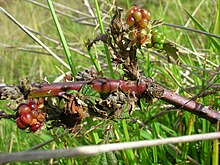Himalayan blackberry
|
Rubus armeniacus Himalayan blackberry |
|
|---|---|
 |
|
| Shoot with immature fruit | |
 |
|
| Scientific classification | |
| Kingdom: | Plantae |
| (unranked): | Angiosperms |
| (unranked): | Eudicots |
| (unranked): | Rosids |
| Order: | Rosales |
| Family: | Rosaceae |
| Genus: | Rubus |
| Subgenus: | Rubus |
| Species: | R. armeniacus |
| Binomial name | |
|
Rubus armeniacus Focke 1874 |
|
Rubus armeniacus, the Himalayan blackberry or Armenian blackberry, is a species of Rubus in the blackberry group Rubus subgenus Rubus series Discolores (P.J. Müll.) Focke. It is native to Armenia and Northern Iran, and widely naturalised elsewhere. Both its scientific name and origin have been the subject of much confusion, with much of the literature referring to it as either Rubus procerus or Rubus discolor, and often mistakenly citing its origin as western European.Flora of North America, published in 2014, considers the taxonomy unsettled, and tentatively uses the older name Rubus bifrons.
In some areas, the plant is cultivated for its berries, but in many areas it is considered a noxious weed and an invasive species.
Rubus armeniacus is a perennial plant which bears biennial stems ("canes") from the perennial root system. In its first year a new stem grows vigorously to its full length of 4–10 m, trailing along the ground or arching up to 4 m high. The stem is stout, up to 2–3 cm diameter at the base, and green or reddish-tinged above if it is exposed to bright sunlight. The leaves on first year shoots are 7–20 cm long, palmately compound with five leaflets. Flowers are not produced on first year shoots. In its second year, the stem does not grow longer, but produces several side shoots, which bear smaller leaves with three leaflets (rarely a single leaflet). These leaflets are oval-acute, dark green above and pale to whitish below, with a toothed margin, and thorns along the midrib on the underside. The flowers are produced in late spring and early summer on panicles of 3–20 together on the tips of the second-year side shoots, each flower 2–2.5 cm diameter with five white or pale pink petals.
The fruit in botanical terminology is not a berry, but an aggregate fruit of numerous drupelets, 1.2–2 cm diameter, ripening black or dark purple. Both first and second year shoots are spiny, with short, stout, curved, sharp spines. Mature plants form a tangle of dense arching stems, the branches rooting from the node tip when they reach the ground.
...
Wikipedia
